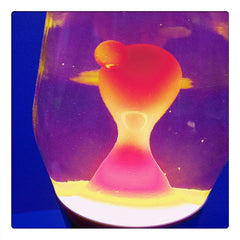In appreciation the Lava Lamp

Nothing says 1960s psychedelia like a Lava Lamp.
Though the black light posters may have long since been rolled up and put away in the attic, the Lava Lamp continues to soothe and calm even the frazzled of nerves, all while looking pretty groovy.
The “motion lamp,” as it’s officially known (since Lava Lamp is a trademarked name), is as simple as oil and water. Motion lamps combine water and an oil/wax/carbon tetrachloride mixture with a 40 watt bulb to heat the wax. The wax expands when heated and rises to the top, where it cools and falls back down to be reheated by the bulb, thus continuing its “psychedelic ballet.”
Though pretty basic in its science, the exact balance of water and wax is a closely guarded secret by manufacturers of motion lamps. It may be hard to image Lava Lamp espionage, but there’s good money to be made even in the most relaxing of light fixtures.
Edward Craven Walker developed the first motion lamp in the UK in 1963 under the name Astro Light. The lamps were fairly successful, but they really “lit up” when the US-based Lava Manufacturing Corp. acquired the US patent rights and began producing their own Lava Lamps in 1965.
The lamps fit in well with mod fashions and interior design, and were seen on with-it TV shows like Dr. Who and The Prisoner. With their atomic shapes and far out colors, the lamps were quickly adopted by the counter culture. Today, the lamps are still seen as symbols of the 1960s, and to this effect a Lava Lamp is part of the Smithsonian Museum’s permanent collection.
But for all the 1960s baggage the Lava Lamp may carry, it’s the soothing rhythm of the floating blobs that sustain its popularity. In the calming glow of a Lava Lamp, it’s nearly impossible to stay stressed out or and uptight. Makes you wonder why more dentists don’t employ them.